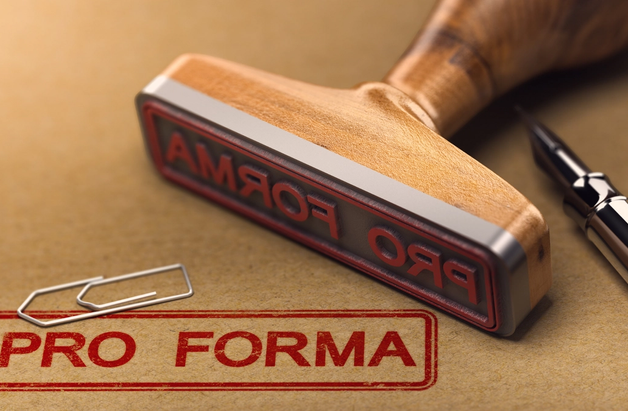Pro Forma Invoice: Meaning, Uses, Required Information & More

June 28, 2023
Whether you’re a business owner or an entrepreneur, you know that there are different types of invoices that you need to prepare, depending on the occasion or the type of transaction. A pro forma invoice is one such type of invoice used for specific types of engagements and serves a key purpose in bringing businesses closer to their customers.
Proforma invoices are different from quotations and commercial invoices. It is important to understand how and when it is best to use a pro forma invoice if you want to maximize your sales and keep your customers happy.
Keep reading to learn more about pro forma invoices and how they differ from other sales and accounting documents.
Key Takeaways
- Pro forma invoices are issued to customers to provide the tentative details of their purchase. Unlike when issuing quotations, a pro forma indicates that the customer has committed to fulfilling their end of the transaction.
- It is ideal to use a pro forma invoice when catering to special orders, estimating costs, establishing transparency with customers, or fulfilling international trades.
- Regular invoices are issued after the goods or services are delivered, while pro forma invoices are sent before the order is completed.
- Pro forma invoices do not have any legal bearing and are also not considered official accounting documents.
What is a Pro Forma Invoice?

A pro forma invoice (also called a proforma or preliminary invoice) is a precursory document sent to a customer who has committed to pushing through with their purchase. Unlike regular invoices, a pro forma invoice contains tentative information about the goods and the total costs in question.
The term "pro forma" means “as a matter of form.” In sales and business, the information provided in preliminary invoices is based on assumed costs and quantities and is, therefore, subject to modification.
Purpose of Pro Forma Invoice
A pro forma invoice is best used when a seller has properly briefed a customer of the possible costs of their purchase while the latter is yet to verify the details of the transaction.
In this case, the proforma shows the customer what they can expect, particularly in terms of the tentative costs and delivery date of the goods or services.
While the terms are not final and are subject to change, think of a pro forma invoice as a guide that helps customers make more informed decisions about their purchases. It describes the contents, rates, and terms of their purchase and gives leeway for the customer to negotiate the conditions of the transaction.
When Should You Send Pro Forma Invoices?
There are specific circumstances where it is appropriate to send a pro forma invoice:
- Trust is established. In a nutshell, issuing a proforma is only effective if both the seller and buyer have already built trust between each other. Both parties are already familiar with each other’s preferences and expectations, so they can engage in transactions with one another in good faith.
- An advanced order is placed. Businesses may also send a proforma if a buyer places an order in advance. The seller prepares the items or services while the buyer inspects the details on the pro forma invoice and has time to prepare the required compensation.
- The prices are up for negotiation. If a customer finds that the prices of their purchase are too high, a proforma comes in handy to pave the way for the vendor and the customer to negotiate the rates.
- The buyer wants to extend the payment terms. At times, a business opts to send a preliminary invoice if the customer wants to adjust the terms of payment and needs more time to prepare the corresponding amount for their purchase.
Why Businesses Use Pro Forma Invoices
There are specific types of trade and sales where it is more fitting to use a pro forma invoice instead of a quotation or a commercial invoice.
Listed below are concrete examples of the use of pro forma invoices in business:
#1. International Trade
Preliminary invoices come in handy for customs in determining the extent of responsibilities tied to goods that are shipped internationally. Since the proforma contains the quantity and description of the product, estimated price, expected delivery time, and payment terms, the customs personnel can better gauge the item’s value and verify its adherence to shipping regulations.
#2. Special Orders
Businesses that tailor their services to suit diverse client requirements are more likely to use a pro forma invoice. This type of invoice gives more freedom for both the business and their client to tweak the conditions included in the invoice and meet halfway.
For instance, the client might make last-minute changes to the list of items on their purchase order. Similarly, a customer may want to purchase more items or adjust the hours they need with regard to hiring one or more of the business’s services.
A preliminary invoice makes it valid for the business to modify the information on the document to accommodate the changes requested by the client.
#3. Estimating Costs
When a sale is still ongoing, and the details of the transaction are pending finalization, creating proforma invoices effectively bridges any gaps between the seller and the buyer.
Technically, a seller is not requesting payment from the buyer when they send a proforma.
In truth, the seller or business is simply keeping the customer informed of the details of the transaction while also accommodating the buyer’s requirements and ensuring the changes are reflected in their agreement.
#4. Establishing Transparency
Preliminary invoices represent agreements between businesses and their customers made in good faith. As such, vendors can use proforma to affirm the integrity and transparency of their operations.\
Customers want to spend on goods and services that are evidently worth their money. At the same time, they are also more willing to purchase from a business that upholds their trust and goes the extra mile to meet their demands and ensure their utmost satisfaction.
Proforma invoices highlight all that and aid businesses with more flexibility in addressing simple to complex client requests.
How to Create a Pro Forma Invoice

A proper pro forma invoice must contain the following information:
- Proforma invoice label. It is placed at the document’s header to ensure the customer distinguishes the invoice as a proforma and understands its purpose at first glance.
- Invoice number. A sequentially arranged number code that is unique to each transaction. Invoice numbers make it easier to monitor customers’ orders.
- Invoice date. It is the date when the proforma invoice was issued.
- Business name, address, and contact information. It must be updated and accurate for better transparency.
- Customer name, address, and contact information. This information identifies the buyer and the address where the goods and invoices are sent.
- Description of the services or goods. The description must be short but concise for the customs staff and other authorities responsible for shipping and delivering goods to conduct the required inspections and take additional precautions in handling the items.
- Itemized quantity goods or services. Simply put, it details the number of items or hours of services requested by the customer.
- Itemized unit price or hourly rates. The unit price and hourly rates help yield the total amount that the customer must pay upon receiving the invoice.
- Taxes. A proforma invoice may not be used for tax purposes, but indicating the tax added to the items’ costs shows that the information is complete and reliable.
- Payment terms. It refers to the length of time given by the seller for the customer to settle payment for their purchase. The payment terms must have been agreed upon by the seller and the buyer.
- Discounts or price adjustments. Adjustments and discounts to the final amount must be specified in the proforma.
- Total amount due. The grand total that the customer has to pay upon receiving the products or services.
The Difference Between a Pro Forma Invoice and an Invoice
The table below enumerates the differences between a pro forma invoice vs invoice, which are as follows:
| Pro Forma Invoice | Invoice |
|---|---|---|
Use | Proforma provides an estimated cost of products or services before they are delivered. Both the seller and buyer have agreed on the prices before the proforma invoice is sent. | An invoice shows the customer the total amount they have to pay in exchange for purchasing goods or acquiring services from a seller or establishment. |
Issuing | Pro forma invoices are sent before the goods or services are received by the buyer. | Invoices are sent to customers after their purchase is fulfilled by the seller. |
Bookkeeping | Pro forma invoices are not included in a business’s accounting records. As such, it does not have any bearing when tracking or updating a business’s finances. | Invoices are official accounting documents included in a business’ accounts payable or receivable records. |
Legal Implications | Technically, a pro forma invoice is considered a pre-sales agreement. However, it does not have any legal implications or bearing on the seller or customer. | Invoices alone are not considered legally-binding contracts unless combined with official contracts signed by both parties involved in a transaction. |
Final Thoughts
A pro forma invoice comes in handy when you want to boost customer satisfaction and foster stronger trust in your services. It is an effective way of showing that you are willing to negotiate and address any concerns customers may have with your services and prices.
Creating a preliminary invoice also exposes any potential errors in your transaction and ensures you address your customer’s requests without compromising your sales and operations.
Furthermore, keep in mind the key distinctions between a regular invoice and a pro forma invoice to avoid possible disputes and repercussions in the event you use the wrong document in your sales.
Pro Forma Invoice FAQ
#1. Is a proforma invoice legally binding?
A proforma invoice is not legally binding. Its main purpose is to provide customers or buyers with an estimate of their purchase and give them an opportunity to verify or approve the details of the transaction.
#2. Can a pro forma invoice be canceled?
A proforma invoice does not need cancellation since it is not considered an official transactional or accounting document. If the customer wants to negotiate a detail in the proforma, all you have to do is apply these changes before sending the document.
#3. What is the difference between a pro forma invoice and a quote?
Proforma invoices are sent once the seller and the buyer have agreed on a price. In contrast to invoices, a quote shows the estimated costs and price range of products and services that a customer is interested in purchasing.
The estimates on a quote are not necessarily based on any prior agreement between the seller and buyer. Also, a quote is issued even if a customer has not expressed their commitment to continue purchasing from the business.
#4. Can a proforma invoice be used for accounting purposes?
No, because proforma invoices are not official accounting documents. It is only used as a preliminary invoice that describes the costs and special requirements included in the sale.
#5. Are taxes included in a pro forma invoice?
While a pro forma invoice contains identical information to that of an invoice, it does not include details about the taxes applied to the transaction. At the same time, the details in a proforma are subject to change depending on the customer’s requests or the type of transaction carried out between the buyer and the seller.
#6. Can you pay a pro forma invoice?
The simple answer is no. You cannot pay a pro forma invoice, especially since it is only used to inform customers about transactional conditions and product prices. It is a preliminary contract between a business and its customer and essentially offers a preview of how the purchase’s final setup should look.


